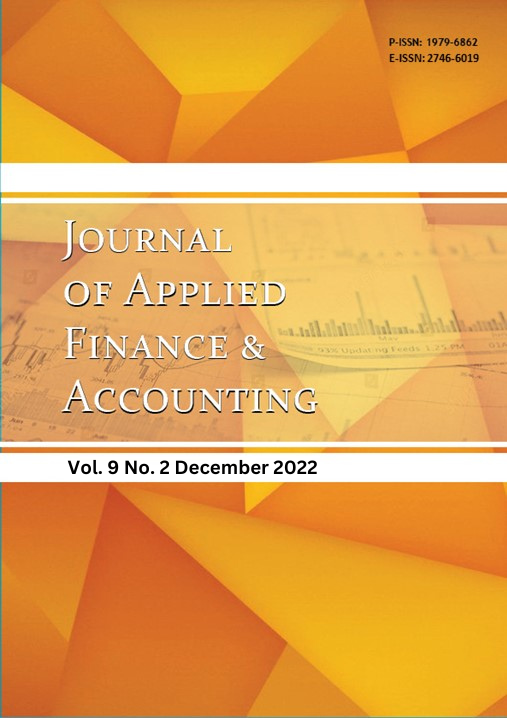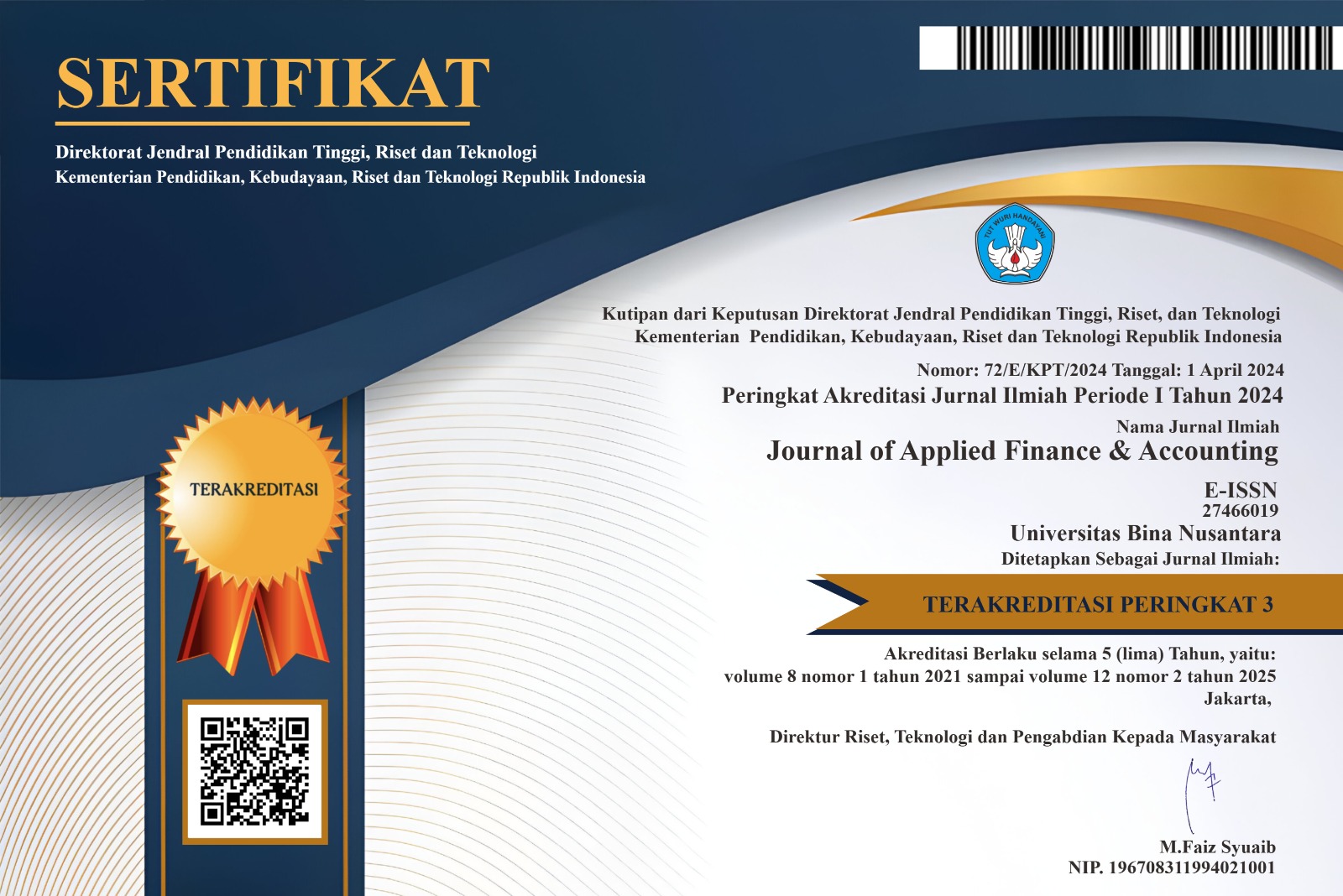DID GOLD, BITCOIN AND FOREX AS SAFE HAVEN ASSET FOR SOUTH EAST ASIA INDEX DURING COVID 19
DOI:
https://doi.org/10.21512/jafa.v9i2.9095Keywords:
Safe Haven Asset, Gold, Bitcoin, US Dollar, GARCH, COVID-19Abstract
The COVID-19 pandemic and the bearish market have led investors to find a safe-haven asset during this financial turbulence. Gold, US Dollar, and Bitcoin traditionally could be safe-haven assets in previous financial crises. However, safe-haven assets are mainly different during each market crash. Therefore, this paper aims to examine gold, US dollars, and Bitcoin as safe-haven assets during the COVID-19 market turmoil in several South East Asian countries such as Indonesia, Malaysia, Singapore, and the Philippines. All variables use daily data time series from January 2020 - September 2020. This study will conduct an empirical analysis using Generalized Autoregressive Conditional Heteroscedasticity (GARCH). Our result shows that during the COVID-19 pandemic, US Dollar could act as a safe-haven asset in Indonesia, Malaysia, and the Philippines. It implies that when the condition is uncertain during a pandemic, many investors switch their investments to US dollars in those three countries. On the other hand, gold and bitcoin are not safe-haven assets, but they could only act as hedging for several countries in South-East Asia.
References
Arfaoui, M., & ben Rejeb, A. (2017). Oil, gold, US dollar and stock market interdependencies: a global analytical insight. European Journal of Management and Business Economics, 26(3), 278–293. https://doi.org/10.1108/EJMBE-10-2017-016
Baur, D. G., & Lucey, B. M. (2010). Is Gold a Hedge or a Safe Haven? An Analysis of Stocks, Bonds and Gold. In The Financial Review (Vol. 45). http://www.merriam-webster.com/.
Baur, D. G., & McDermott, T. K. (2010). Is gold a safe haven? International evidence. Journal of Banking and Finance, 34(8), 1886–1898. https://doi.org/10.1016/j.jbankfin.2009.12.008
Baur, D. G., & McDermott, T. K. J. (2016). Why is gold a safe haven? Journal of Behavioral and Experimental Finance, 10, 63–71. https://doi.org/10.1016/j.jbef.2016.03.002
Bureau of Labor Statistics. (2021). https://www.bls.gov/news.release/pdf/empsit.pdf. Viewed 6 January 2021
Bollerslev, T. (1986). Generalized Autoregressive Conditional Heteroskedasticity. In Journal of Econometrics (Vol. 31).
Boubaker, H., Cunado, J., Gil-Alana, L. A., & Gupta, R. (2020). Global crises and gold as a safe haven: Evidence from over seven and a half centuries of data. Physica A: Statistical Mechanics and Its Applications, 540. https://doi.org/10.1016/j.physa.2019.123093
Bouri, E., Molnár, P., Azzi, G., Roubaud, D., & Hagfors, L. I. (2017). On the hedge and safe haven properties of Bitcoin: Is it really more than a diversifier? Finance Research Letters, 20, 192–198. https://doi.org/10.1016/j.frl.2016.09.025
Bouri, E., Shahzad, S. J. H., Roubaud, D., Kristoufek, L., & Lucey, B. (2020). Bitcoin, gold, and commodities as safe havens for stocks: New insight through wavelet analysis. Quarterly Review of Economics and Finance, 77, 156–164. https://doi.org/10.1016/j.qref.2020.03.004
BPS. (2020). https://www.bps.go.id/. Viewed 3 October 2020
Bredin, D., Conlon, T., & Potì, V. (2015). Does gold glitter in the long-run? Gold as a hedge and safe haven across time and investment horizon. International Review of Financial Analysis, 41, 320–328. https://doi.org/10.1016/j.irfa.2015.01.010
Capie, F., Mills, T. C., & Wood, G. (2005). Gold as a hedge against the dollar. Journal of International Financial Markets, Institutions and Money, 15(4), 343–352. https://doi.org/10.1016/j.intfin.2004.07.002
Chambers, M. (2020). German exports plunge as coronavirus wrecks demand in April. Reuters. https://www.reuters.com/article/us-germany-economy-tradefigures-idUKKBN23G0M0
Cheema, M. A., Faff, R., & Szulczyk, K. R. (2020). The 2008 Global Financial Crisis and COVID-19 Pandemic: How Safe are the Safe Haven Assets? https://ssrn.com/abstract=3590015
CoinMarketCap. (2020). https://coinmarketcap.com/currencies/bitcoin/historical-data/.
Conlon, T., Corbet, S., & McGee, R. J. (2020). Are cryptocurrencies a safe haven for equity markets? An international perspective from the COVID-19 pandemic. Research in International Business and Finance, 54. https://doi.org/10.1016/j.ribaf.2020.101248
Conlon, T., Lucey, B. M., & Uddin, G. S. (2018). Is gold a hedge against inflation? A wavelet time-scale perspective. Review of
Quantitative Finance and Accounting, 51(2), 317–345. https://doi.org/10.1007/s11156-017-0672-7
Conlon, T., & Mcgee, R. (2020). Safe Haven or Risky Hazard? Bitcoin during the Covid-19 Bear Market. Finance Research Letter.
Coudert, V., Guillaumin, C., & Raymond, H. (2014). Looking at the Other Side of Carry Trades: Are there any Safe Haven Currencies? CEPII Working Paper. www.cepii.fr
Dutta, A., Das, D., Jana, R. K., & Vo, X. V. (2020). COVID-19 and oil market crash: Revisiting the safe haven property of gold and Bitcoin. Resources Policy, 69. https://doi.org/10.1016/j.resourpol.2020.101816
Enders, W. (2014). Applied Econometric Time Series (4th ed.). John Wiley & Sons, Inc.
Fatum, R., & Yamamoto, Y. (2016). Intra-safe haven currency behavior during the global financial crisis. Journal of International Money and Finance, 66, 49–64. https://doi.org/10.1016/j.jimonfin.2015.12.007
Fernandes, N. (2020). Economic effects of coronavirus outbreak (COVID-19) on the world economy. https://ssrn.com/abstract=3557504
Gates, B. (2020). Responding to Covid-19 - A once-in-a-century pandemic? In New England Journal of Medicine (Vol. 382, Issue 18, pp. 1677–1679). Massachusetts Medical Society. https://doi.org/10.1056/NEJMp2003762
Greene, W. H. (2003). Econometric analysis (5th ed.). Prentice Hall.
Grisse, C., & Nitschka, T. (2013). On financial risk and the safe haven characteristics of Swiss franc exchange rates. Journal of Empirical Finance, 32, 153–164. https://doi.org/10.1016/j.jempfin.2015.03.006
Habib, M. M., & Stracca, L. (2012). Getting beyond carry trade: What makes a safe haven currency? Journal of International Economics, 87(1), 50–64. https://doi.org/10.1016/j.jinteco.2011.12.005
Indonesia Ministry of Health. (2020). https://www.kemkes.go.id/. Viewed 3 October 2020
Investing. (2020). https://www.investing.com/currencies/. Viewed 21 October 2020
Ji, Q., Zhang, D., & Zhao, Y. (2020). Searching for safe-haven assets during the COVID-19 pandemic. International Review of Financial Analysis, 71. https://doi.org/10.1016/j.irfa.2020.101526
Kopyl, K. A., & Lee, J. B. T. (2016). How safe are the safe haven assets? Financial Markets and Portfolio Management, 30(4), 453–482. https://doi.org/10.1007/s11408-016-0277-5
Lucey, B. M., & Li, S. (2015). What precious metals act as safe havens, and when? Some US evidence. Applied Economics Letters, 22(1), 35–45. https://doi.org/10.1080/13504851.2014.920471
McCauley, R. N., & McGuire, P. (2009). Dollar appreciation in 2008: safe haven, carry trades, dollar shortage and overhedging. BIS Quarterly Review.
Musialkowska, I., Kliber, A., Świerczyńska, K., & Marszałek, P. (2020). Looking for a safe-haven in a crisis-driven Venezuela: The Caracas stock exchange vs gold, oil and bitcoin. Transforming Government: People, Process and Policy, 14(3), 475–494. https://doi.org/10.1108/TG-01-2020-0009
Ranaldo, A., & Söderlind, P. (2010). Safe haven currencies. Review of Finance, 14(3), 385–407. https://doi.org/10.1093/rof/rfq007
Reboredo, J. C. (2013). Is gold a safe haven or a hedge for the US dollar? Implications for risk management. Journal of Banking and Finance, 37(8), 2665–2676. https://doi.org/10.1016/j.jbankfin.2013.03.020
Shahzad, S. J. H., Bouri, E., Roubaud, D., Kristoufek, L., & Lucey, B. (2019). Is Bitcoin a better safe-haven investment than gold and commodities? International Review of Financial Analysis, 63, 322–330. https://doi.org/10.1016/j.irfa.2019.01.002
Shahzad, S. J. H, Bouri, E., Roubaud, D., & Kristoufek, L. (2020). Safe haven, hedge and diversification for G7 stock markets: Gold versus bitcoin. Economic Modelling, 87, 212–224. https://doi.org/10.1016/j.econmod.2019.07.023
Smales, L. A. (2019). Bitcoin as a safe haven: Is it even worth considering? Finance Research Letters, 30, 385–393. https://doi.org/10.1016/j.frl.2018.11.002
Smith, R. D. (2006). Responding to global infectious disease outbreaks: Lessons from SARS on the role of risk perception, communication and management. Social Science and Medicine, 63(12), 3113–3123. https://doi.org/10.1016/j.socscimed.2006.08.004
Tversky, A., & Kahneman, D. (1991). Loss Aversion In Riskless Choice: A Reference-Dependent Model. The Quarterly Journal of Economics.
Urquhart, A., & Zhang, H. (2019). Is Bitcoin a hedge or safe haven for currencies? An intraday analysis. International Review of Financial Analysis, 63, 49–57. https://doi.org/10.1016/j.irfa.2019.02.009
Wen, X., & Cheng, H. (2018). Which is the safe haven for emerging stock markets, gold or the US dollar? Emerging Markets Review, 35, 69–90. https://doi.org/10.1016/j.ememar.2017.12.006
World Health Organization. (2020). https://www.who.int/emergencies/diseases/novel-coronavirus-2019. Viewed 3 October 2020
Worthington, A. C., & Pahlavani, M. (2007). Gold investment as an inflationary hedge: Cointegration evidence with allowance for endogenous structural breaks. Applied Financial Economics Letters, 3(4), 259–262. https://doi.org/10.1080/17446540601118301
Yahoo Finance. (2020). https://finance.yahoo.com/world-indices. Viewed 21 October 2020
Downloads
Published
Issue
Section
License
Authors who publish with this journal agree to the following terms:
Authors retain copyright and grant the journal right of first publication with the work simultaneously licensed under a Creative Commons Attribution License that allows others to share the work with an acknowledgement of the work's authorship and initial publication in this journal.
Authors are able to enter into separate, additional contractual arrangements for the non-exclusive distribution of the journal's published version of the work (e.g., post it to an institutional repository or publish it in a book), with an acknowledgement of its initial publication in this journal.
Authors are permitted and encouraged to post their work online (e.g., in institutional repositories or on their website) prior to and during the submission process, as it can lead to productive exchanges, as well as earlier and greater citation of published work (See The Effect of Open Access).





